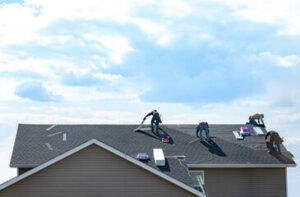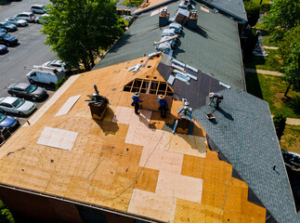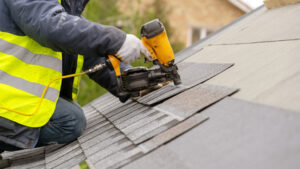Whether you’re building a new house or re-roofing your current home, the roofing materials you choose will significantly impact both the initial construction costs and long-term maintenance and energy costs. Here are some tips to help you make the right choice.
When installing metal panels, be sure to use foam closure strips to keep insects out. Also, be sure to follow the manufacturer’s instructions on screwing down panels and adjusting them for expansion and contraction. Contact Fort Myers Roofing now!

When you choose to roof your new home or renovate an existing one, you have many different roofing materials to select from. Whether it’s clay and concrete tiles, asphalt shingles, wood shake or slate, there are many factors to consider including cost, durability, lifespan and warranty. Consulting with a roofing expert is a good way to understand the different options available and how they can enhance your home’s overall appearance, style and value.
Choosing the right roofing material will make your home more comfortable, protect it from storm damage and help reduce energy costs. But more importantly, it will communicate your style and personality to the world. Depending on your architectural design, you should find a roofing material that complements the structure and color scheme of your house. It should also be able to withstand the weather conditions in your area.
The most popular residential roofing materials are asphalt shingles, which come in various colors and styles to match the aesthetic of your home. They are durable, affordable and offer protection against hail and fire. They can last for 30 years or more if properly maintained.
Slate is a durable roofing material that offers timeless elegance. The natural material can withstand strong winds and snow, resist moisture and prevent fires. However, it is heavy and requires additional framing during installation.
Another type of flat roof is a single-membrane system. EPDM (ethylene propylene diene rubber) membrane, TPO (thermoplastic polyolefin) and PVC are common choices for homeowners. They are durable, affordable and water-resistant, but they can be brittle over time.
Other roof treatments include elastomeric coatings, which are essentially paints that have added flexibility to a roof. This coating can seal cracks and seams and lasts for 10-20 years. Another option is a metal roof, which is an excellent choice for homes in harsh climates. It can withstand high winds, hail and rain. Metal roofs can last for 50-100 years and are available in a wide variety of styles, from standing seam to shingle look-alikes. When selecting a roof treatment, you should evaluate its durability, lifespan, and warranty to ensure that it’s suitable for your climate.
When homeowners build or re-roof their homes, they have a lot of choices. Shingles, the most popular roofing material, come in a variety of different styles to fit any aesthetic. They can also protect the interior of a home from harsh UV rays.
Most people are familiar with asphalt shingles. These are commonly seen on roofs of traditional, ranch and modern homes. In addition to standard 3-tab shingles, manufacturers now produce premium shingles that offer a more attractive appearance. They also have the advantage of being lighter and less expensive than other roofing materials.
Because shingle roofs don’t require any special construction techniques, they are often the most affordable option for new and re-roofing projects. They also are more easily repaired than other roof types, lowering the cost of maintenance and replacement over time.
Unlike metal roofing, shingles insulate the home from sound. This can make a big difference in the comfort of the interior and reduce energy costs. Shingles can also withstand heavy rains and hail, making them a reliable choice in stormy weather.
Many shingles are designed to mimic the look of other types of roofs, such as slate and cedar shakes. Some have been treated with preservatives to resist rot and other environmental hazards. Depending on the type of shingle and your climate, you may want to consider an algae-resistant product.
Most of the people who get shingles have had chickenpox in the past, and the herpes zoster virus that caused that illness continues to reside in nerve cells around the body. When the virus becomes active again, you develop the rash known as shingles.
The shingles rash appears in a band on one side of the body or face, corresponding to the area where the nerves that transmit signals are located. It starts as groups of tiny pimples that soon turn into pus-filled blisters that scab over within about 7-10 days. After the scabs are gone, the blisters disappear from the skin in about 2-4 weeks and your symptoms will have passed. While most people only get shingles once, the virus can return later in life, usually in adults who have weakened immune systems.
While it’s often overlooked, roof underlayment is a crucial part of your home’s roofing system. Typically made from asphalt-saturated felt or synthetic materials, it provides a secondary layer of protection that helps to keep water during a rain event from infiltrating your home’s roof. It’s important to note that there are different types of underlayment, so it’s essential to know which type your roofer is using.
Felt paper underlayment — also called roofing felt or tar paper — is the most common type of underlayment used on homes with shingles and is commonly available at hardware stores. It’s typically easy to install, inexpensive, and provides basic soundproofing and moisture/vapor protection. However, it can deteriorate quickly when exposed to sunlight, so you may want to consider other options if your client lives in a hot climate.
Asphalt-saturated felt underlayment is a more durable option that’s often used in areas of the roof that are vulnerable to leaks, like eaves, valleys, and vents. It’s typically a bit more expensive than the 15-pound option, but it offers greater water resistance and can be used in layers to offer superior protection.
Rubberized asphalt underlayment is a popular choice that contains rubber and asphalt polymers to help make it extra waterproof. It’s a good choice for high-pitch roofs, and it can be installed in multiple layers to provide maximum protection. It’s also self-adhering and self-sealing, meaning it can help to prevent lateral moisture migration as well as seal around staples or nails that are used during installation.
Non-bitumen synthetic underlayment is another type of underlayment that’s becoming more popular. It’s a durable option that can be used in multiple layers, and it’s typically less expensive than other types of underlayment. It’s also resistant to fungus and other types of mold, making it a good choice for areas of the roof that are frequently wet. It’s a great choice for eaves, valleys, vents, and skylights. It’s also self-adhering, so it can help to reduce the risk of ice damming in cold climates. In addition, it can be used as a base for some roofing systems, including metal and tile.
A roofing professional will use flashing to cover the seams around structures that penetrate a roof like chimneys, skylights, dormers and walls. It protects against water leaks that can cause rot, mildew, mold and other damage.
Essentially, flashing is a thin sheet of metal bent into shape to fit into a joint. It is typically installed around areas where the roof pitch changes, at eaves and along rakes. It also covers penetrations, such as vent pipes, chimneys and skylights. Flashing is made of a variety of materials including copper, aluminum and galvanized steel.
The best type of flashing to install in your home depends on the climate where you live. In general, copper and aluminum flashing hold up well against the elements and are considered the longest-lasting options. They require little maintenance, but should be inspected for wear and tear once a year.
Galvanized steel flashing is less expensive than copper and holds up well against the weather. However, it can rust over time, so you should consider having it painted or coated with an appropriate material to extend its lifespan.
A common flashing is step flashing, which is used in the junction of a sloped roof and a perpendicular structure such as a wall or chimney. It consists of a series of small pieces that overlap and look much like fish scales.
In addition to chimney flashing and roof flashing, there is base flashing, kickout flashing, saddle flashing and counter flashing. While the exact type of flashing you need may depend on the location of your roof and the types of penetrations in it, a roofing professional will always take these factors into consideration to ensure your home is protected against leaks.
One of the most important purposes of flashing is to stop water from seeping under shingles and other roof materials, which can lead to rot, mildew and mold, as well as insect infestations. This can occur when rainwater, ice or snow seeps under the roof shingles and into the home. While sealant can be used to fill in minor cracks, flashing is a much more effective solution for preventing water penetration.

